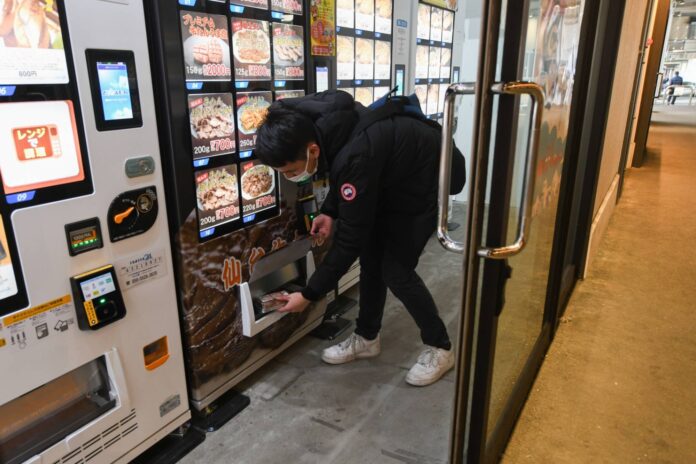
Vending machines are ubiquitous – you can find them in offices, schools, hospitals, and many other locations. The convenience of grabbing a snack or drink without leaving your building makes vending machines a popular option. But if you’re considering buying a vending machine for your business or other venues, one of the first questions is likely “How Much Does a Vending Machine Cost?”
How Much Does a Vending Machine Cost can vary quite a bit based on the type, size, features, and capabilities. On average, plan to spend between $3,000 to $10,000+ for a new automated retail machine. Used and reconditioned machines are also available at a lower cost.
In this comprehensive guide, we’ll break down How Much Does a Vending Machine Cost along with the many factors that influence pricing. You’ll learn strategies for reducing expenses and calculating potential return on your investment. With this information, you can determine the most affordable way to offer vending services while still providing convenience and selections your customers will appreciate.
Types of Vending Machines and Associated Costs
There are a few main categories of vending machines, each with typical price ranges. How Much Does a Vending Machine Cost depends on factors like size, number of selections, features, and the products vented.
Traditional Vending Machines
These are the classic vending machines that dispense canned beverages, snacks, candy, gum, and other non-perishable food items. The cost for a new traditional vending machine ranges from $3,000 to $5,000 on average. These tend to be relatively affordable, with basic features to simply store and dispense shelf-stable foods.
A traditional glass-front snack machine holding around 30-40 selections may cost on the lower end around $3,000. A larger machine with 80-100 snack selections could run $4,000 to $5,000. Soda/beverage machines are typically more expensive than snack machines.
Refrigerated Food Vending Machines
These vending machines include refrigeration components to keep food and drinks cool. Refrigerated machines cost more than traditional non-refrigerated machines. Plan for an investment of $6,000 to $10,000 for a refrigerated vending machine.
The increased cost covers the addition of a cooling system to keep items at safe temperatures. Refrigerated machines require more maintenance as well. They are necessary for vending perishable foods and cold beverages.
Combo Vending Machines
Combo machines combine different vending machine types into one unit. For example, a combo snack and drink machine may have cold beverages on the bottom and shelf-stable snacks on the top.
These combo machines provide more variety and selection but at an increased price point. Expect to spend $8,000 to $12,000 for a new combination vending unit.
High-End Specialty Vending Machines
On the higher end of the spectrum, specialty vending machines for premium or unusual items can cost over $10,000 per unit. Examples include:
- Electronics vending machines for phones, laptops, cameras, etc.
- High-value luxury vending machines for jewelry, perfume, ties, etc.
- Fresh food machines for salads, sandwiches, fruit, yogurt, etc.
- Wine, beer, and champagne vending machines
- Automated retail kiosks provide services beyond just vendor goods
The sky’s the limit for unique high-end vending machines tailored to specific products or audiences. Be prepared for a hefty price tag for customization and advanced features. The cost may exceed $20,000+ in some cases. Now, you have a better understanding of How Much Does a Vending Machine Cost.
What Factors Influence in How Much Does a Vending Machine Cost?
Many factors beyond just the type of machine impact the overall price tag. When purchasing a unit, consider the following cost drivers, including How Much Does a Vending Machine Cost:
Size and Capacity
The larger the vending machine, the higher the cost. Large-capacity machines hold more products and selections. Popular snack machines may have 20-40 selections, while jumbo machines can hold 80-100 different SKUs.
The greater capacity allows for more sales volume, but the bigger size also raises the base price. Carefully consider your location and anticipated demand when choosing the right machine size.
Features and Capabilities
Basic vending machines simply store and dispense products. Enhanced features increase convenience and this is the answer to How Much Does a Vending Machine Cost:
- Refrigeration – Cools machine between 32-40°F for cold drinks and perishable foods.
- Heating – Heats items like hot drinks and soups between 130-165°F.
- Touchscreens – Allows for dynamic menus, advertising, and enhanced user experience.
- Telemetry – Remote machine monitoring, sales data, inventory tracking.
- Credit card readers – Allows cashless purchases with debit/credit cards.
- Custom branding/wrapping – Custom exterior graphics and signage.
- Security features – Cameras and alarm systems to prevent break-ins.
Only include features that will benefit your audience and help drive sales. Avoid unnecessary add-ons that won’t get utilized.
Type of Products Vended
Vending consumable non-food items like snacks and soda is most affordable since no refrigeration is required. Once you get into perishable foods, equipment costs go up significantly.
Food safety regulations also come into play with guidelines on temperature control, hygiene, cleaning procedures, and maintenance. Follow local health codes for vending fresh and frozen items.
Warranties, Support, and Financing
Reputable vending machine companies include product warranties and support. This provides peace of mind but increases the purchase price.
Financing spreads payments over time but with interest charges. Compare financing offers before agreeing so you understand the total cost.
Additional Expenses Beyond the Vending Machine Itself
The vending machine is certainly the largest upfront investment, but it’s not the only cost involved in starting a vending business. Be ready for other potential expenses including: How Much Does a Vending Machine Cost?
Location Fees and Commissions
If placing your machine in a high-traffic area like an office building or school, the location owner may charge monthly rent or commission on sales. This can range from 5-30% of revenue.
Shipping and Installation
Getting the machine to your facility and properly installing it adds to startup costs. Bulkier units may require special shipping accommodations like lift gates on trucks. Expect to spend $200-$500 or more for transportation and setup.
Initial Machine Stocking
You’ll need an appealing mix of products to rotate through the machine. Inventory to first stock the unit can run $300-$1000 depending on machine size and selections.
Cash for Making Change
Ensure you have plenty of small bills and coins for the bill validator and change dispenser. Have at least $50-$100 per machine on hand.
Ongoing Consumable Costs
As items sell, you’ll continually need to restock inventory and replace bestselling selections. Factor in these recurring product costs.
Maintenance and Cleaning
Regular machine maintenance and cleaning keep everything running smoothly. Budget $50-$100 per month per machine for service costs.
Transaction Fees
If allowing credit/debit card purchases, the payment processor charges per-transaction fees around 3% of the sale amount.
Strategies to Reduce Price – How Much Does a Vending Machine Cost
Here are some tips to minimize expenses when starting or expanding a vending business:
Buy Used/Reconditioned Machines
Gently used machines cost 30-50% less than brand-new units. Look for refurbished machines from reputable sellers.
Start Small to Test Demand
Try one or two machines in your location before investing in a full bank of multiple units.
Choose Basic Models with Only Essential Features
Avoid unnecessary bells and whistles like touchscreens if they won’t enhance sales.
Partner with Suppliers for Discounted Equipment
Work with vendors you plan to buy inventory from – they may offer reduced machine pricing.
Reduce Shipping Costs with Local Sellers
Source machines nearby to eliminate expensive freight fees.
Split Machine Costs with Other Vendors
Share a machine with complementary products – one vends snacks while the other sells cold drinks.
Consider Leasing Options
Leasing may minimize upfront capital requirements. Compare monthly lease rates to long-term loan payments.
Offer Advertising Space
Generate additional income by selling space for ads on the machine exterior.
Calculating Potential Return on Vending Machine Investments
With an average price point of $3-$10 per transaction from a vending machine, the question of “How Much Does a Vending Machine Cost” becomes crucial. Carefully project expected profitability before acquiring machines so you can estimate your ROI timeframe and avoid disappointment.
- Consider the number of potential customers in your location – more foot traffic means faster sales velocity.
- Research typical vended product margins. Staple items like sodas may be 25-30% profit while premium snacks could return 40-50% profit per sale.
- Factor in ongoing expenses like consumables, maintenance, transaction fees, rent, etc. These will reduce net profits.
- Estimate a target number of sales per machine per week based on location traffic patterns.
- Plug these assumptions into a business plan spreadsheet to calculate when you may recoup your initial machine investment. Update projections with actual sales data once operating.
According to VendWeb, a full-service vending operation in a busy location can generate around $6000 per machine annually after expenses. In a slower location, plan for $1500-$3000 net profit per year per machine.
With strong site selection and efficient operation, a quality vending machine should fully pay for itself in 1-3 years. Ongoing profits can then make the business very lucrative.
Key Takeaways on How Much Does a Vending Machine Cost
Vending machines represent a significant upfront investment of $3000 to $10,000 each depending on the type, size, features, and products vented. Major factors that increase costs include refrigeration, touchscreens, expanded capacity, and specialty vending capabilities.
Beyond the machine itself, prepare for additional expenses like location fees, maintenance, cash to make change, and inventory. Carefully project sales volumes and profits to determine how quickly you can earn back your investment in a vending machine.
To minimize costs, start small, buy used equipment, avoid unnecessary features, and reduce shipping fees. While vending requires sizeable startup funds, the ongoing passive revenue from machines in high-traffic areas can ultimately deliver an attractive return.
Conclusion
Determining the exact cost of a vending machine depends on many variables. But with this guide examining price ranges, expense considerations, and tips for reducing costs, you now have the information needed to budget for a profitable vending business.
You can make an informed decision on acquiring affordable machines suited for your location and target audience. Calculating the potential return on investment will give you confidence that the equipment costs can be recouped from vending sales over a reasonable timeframe.
So when considering adding the convenience of vending to your office, school, hospital, or other venue, you can answer the key question “How much does a vending machine cost?” and make plans based on your budget and business goals.












